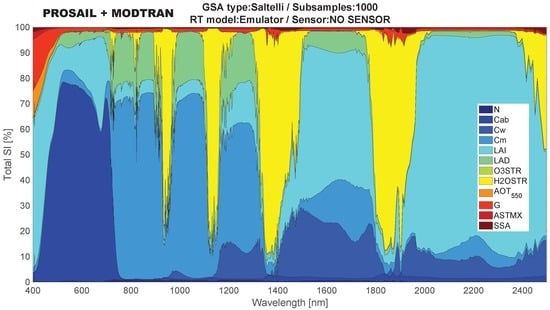Global Sensitivity Analysis of Leaf-Canopy-Atmosphere RTMs: Implications for Biophysical Variables Retrieval from Top-of-Atmosphere Radiance Data
Abstract
1. Introduction
2. The Sentinel-2 Mission
3. Materials and Methods
3.1. Developed Toolboxes for Automated Processing
- Atmospheric Look-up table Generator (ALG) [19] is an independent software tool that can be plugged into ARTMO and allows generating and analyzing LUTs based on a suite of atmospheric RTM, i.e., MODTRAN, 6SV, libRadtran.
- A new so-called “TOC2TOA” toolbox has been developed to enable coupling surface reflectance simulations with atmospheric simulations, i.e., to reach TOA radiance data. The TOC2TOA toolbox couples the atmospheric transfer functions with canopy reflectance simulations or observations to enable TOA radiance data, thereby ensuring that consistent geometry at canopy and atmosphere is preserved. Either canopy LUTs, surface reflectance data, e.g., from a field spectroradiometer, or a BOA reflectance image can be coupled with atmospheric transfer functions to enable uppscaling to TOA radiance data. In this version (1.0), the coupling assumes a Lambertian and homogeneous surface according to the formulation proposed in [54].
- The Global Sensitivity Analysis (GSA) toolbox [55] calculates a global sensitivity analysis on RTMs. The GSA toolbox enables to identify key driving input variables as well as non-influential input variables across the spectral range of spectral outputs. The main limitation of GSA is that it requires many simulations, and is thus limited by the processing speed of the model under study [32].
- The machine learning regression algorithms (MLRA) toolbox [56] is one of ARTMO’s retrieval toolboxes. The MLRA toolbox contains over 20 MLRAs that can be trained and validated with either experimental or RTM data. Afterwards, a selected model can be applied to an image for mapping applications.
3.2. Description of Simulated Datasets
3.3. Global Sensitivity Analysis (GSA)
3.4. Emulation
3.5. Hybrid Retrieval Schemes
3.6. Retrieval of Biophysical Variables from Sentinel-2 L1C and L2A Images
4. Results
4.1. Global Sensitivity Analysis Results
- Generally, the GSA results indicate that atmospheric variables had a weaker influence than vegetation variables. Regarding the atmospheric variables, clearly, the HO content had a strong impact in discrete parts of the spectrum, in agreement with the location of HO absorption bands. Relatively small impact bands can be found at 820 nm, while stronger impact (over 70% ) in the region of 900–950 nm and 1100–1150 and the largest impact bands (over 80% ) between 1350–1450 and between 1800–1900 nm where the HO absorption saturates.
- The aerosol optical properties (extinction, absorption and phase function) were the most dominant atmospheric variables. Particularly, the AOT and phase function (through the Henyey-Greenstein parameter, G) had a relatively strong impact (30% ) in the region of 400 to 500 nm, where the scattering is higher. This impact diminishes to a few percents in the range of 500 to 1300 nm and with barely any influence after 1300 nm. According to the GSA results, the O seemed not to have a relevant influence over the variance of the TOA radiance even at the bottom of the Chappuis absorption band (400–650 nm) where the O absorption is higher.
- Among vegetation variables, at the leaf level, chlorophyll content (Cab) was the main driver of TOA radiance in the visible range (450–750 nm) with over 60% , while dry matter content (Cm) was the main driver in the NIR range (750 to 1200 nm), 70%. Water content (Cw) had a negligible impact on the visible and the NIR but had a considerable impact in the SWIR (1400 to 2500 nm), with up to 20%. These three variables explain more than the 60% of the variance along the visible and NIR spectral range (400–1400 nm). The leaf layer variable (N) had a rather weak influence, but it covered the whole spectral range. Among canopy variables, LAI is the most dominant variable. It has influence along the whole spectral range, but it becomes especially dominant from 1400 nm onwards. LAI especially dominates the 2000–2400 nm SWIR region with a of around 80%.
4.2. Biophysical Variables Retrieval
- Overall, no systematic differences between TOC and TOA can be observed. About the same patterns appeared with low for the majority of bands. This suggests that models can be developed from both TOC and TOA data sources with about the same degree of retrieval success.
- A closer inspection towards Cab and LAI reveals that TOA data led to considerably higher for some bands (i.e., 490, 783 and 865 nm for Cab; 490 and 740 nm for Cw). This suggests that for these variables the TOA data has more difficulty to develop the retrieval algorithms. Conversely, the similarity between the TOC and TOA bands for the LAI models suggests that the role of atmosphere is of marginal importance for LAI retrieval.
- For all variables, the band in the blue is evaluated as poorly contributing, both for TOC and TOA. For TOA this can be explained by the influence of aerosols, while at TOC scale this may be rather due to the remaining impact of the aerosols in the atmospheric correction. It is also of interest that the SWIR bands play an important role for TOC and TOA retrieval algorithms.
5. Discussion
5.1. Emulation of Leaf-Canopy-Atmosphere RTMs
5.2. GSA
5.3. TOC and TOA Retrieval Models
- Regarding the Cab models, the most relevant bands (low ) for both TOC and TOA fall within the visible region which is justified by the high sensitivity of Cab. The rapidly declines when entering the red edge, which is also observed by the higher sigmas. Of interest hereby are the relatively high importance of the two SWIR bands, even though the GSA results show Cab has no influence there. This has to be interpreted by indirect co-varying relationships between LAI and Cab. After all, Cab absorption only occurs when leaves are available (which in turn reduce the role of soil background). The amount of leaves is controlled by LAI [53,87].
- Regarding the Cw models, the most relevant bands for both TOC and TOA are found in the 1610 and 2190 nm SWIR bands. These are regions where Cw plays an important role. Further, the band ranking suggest that also the visible bands are of importance, which can be again attributed to co-varying relationships with other leaf properties such as Cab and the amount of leaves, i.e., LAI [53,87].
- Regarding the LAI models, relevant bands are found all throughout the spectra with lowest in the red (665 nm), and especially in the two SWIR bands. This is again in agreement with the GSA results where LAI is dominant in the SWIR.
- Obtained maps from L1C and L2A data are surprisingly consistent given that no optimization steps were applied. Yet, it must be remarked, the images were acquired on a clear-sky summer day for a flat surface, making that the role of atmosphere is predominantly homogeneous and predictable. Obviously the retrieval from TOA data will be more challenging in a more rugged terrain and in atmospheric heterogeneous conditions, e.g., haze, clouds and shadowing effects. With the offered toolboxes (ALG, TOC2TOA, GSA, retrieval) these effects can be studied, and specific retrieval strategies developed.
- The TOC and TOA models were trained by simulated data using RTMs that deal with spectral variability of homogeneous vegetated surfaces. Although 20 soil spectral signatures were added to the training, that is definitely not enough to cover the natural variability of non-vegetated surfaces at S2 spatial resolution for complete images. For instance, the models are not trained for water bodies and man-made surfaces. Ideally, spectral variability of all kinds of non-vegetated surfaces should be added to the training dataset. Similarly, most likely the model performs poorly over heterogeneous vegetated surfaces such as forests.
- Another way how to further optimize the training LUT for operational mapping is by using sample distributions that reflect reality more, e.g., normal or log-normal distributions for key variables. A more refined LUT may be necessary to mitigate the drawback of the LAI saturation. It is expected that by refining the LUT, e.g., excluding unrealistic situations the LAI model will be greatly improved, e.g., that saturation only occurs at higher LAI (>6). This is also the strategy in the official S2 vegetation algorithms as found within the SNAP toolbox [95].
- There are some aspects of the obtained maps from L1C and L2A data that require clarification. For instance, the fact that L2A-retrieved Cab is more pronounced than the one from L1C might indicate that the atmosphere has still some impact on the Cab. Indeed, aerosol properties have some influence in the AOT (although according to the GSA results this influence is residual <5%). The same holds for LAI, since LAI is also sensitive to the visible part (not only in the SWIR). Regarding Cw, their similarities in the obtained L1C vs L2A maps can be explained from the GSA, since Cw is mostly impacting in the SWIR range, where outside the water absorption bands the atmosphere has little influence. In this respect, it can be understood that Cw achieves the same performance from L1C or from L2A data.
- As a final remark, the TOA reflectance to TOA radiance conversion as well the Sen2Cor TOA (L1C) to BOA (L2A) conversion is done with routines based on the libRadtran RTM. These differences may lead to discrepancies as compared to the here used MODTRAN routines. For instance, the S2 processing uses the Thuillier [96] solar irradiance, while MODTRAN uses the Kurucz [97]. The role of using different atmospheric RTMs in atmospheric correction and in TOA radiance biophysical variables retrieval is yet to be investigated.
5.4. ARTMO Toolboxes
6. Conclusions
Author Contributions
Funding
Acknowledgments
Conflicts of Interest
References
- Malenovský, Z.; Rott, H.; Cihlar, J.; Schaepman, M.E.; García-Santos, G.; Fernandes, R.; Berger, M. Sentinels for science: Potential of Sentinel-1, -2, and -3 missions for scientific observations of ocean, cryosphere, and land. Remote Sens. Environ. 2012, 120, 91–101. [Google Scholar] [CrossRef]
- Verrelst, J.; Rivera, J.; Van Der Tol, C.; Magnani, F.; Mohammed, G.; Moreno, J. Global sensitivity analysis of the SCOPE model: What drives simulated canopy-leaving sun-induced fluorescence? Remote Sens. Environ. 2015, 166, 8–21. [Google Scholar] [CrossRef]
- Drusch, M.; Del Bello, U.; Carlier, S.; Colin, O.; Fernandez, V.; Gascon, F.; Hoersch, B.; Isola, C.; Laberinti, P.; Martimort, P.; et al. Sentinel-2: ESA’s Optical High-Resolution Mission for GMES Operational Services. Remote Sens. Environ. 2012, 120, 25–36. [Google Scholar] [CrossRef]
- North, P.; Brockmann, C.; Fischer, J.; Gomez-Chova, L.; Grey, W.; Heckel, A.; Moreno, J.; Preusker, R.; Regner, P. MERIS/AATSR synergy algorithms for cloud screening, aerosol retrieval and atmospheric correction. In Proceedings of the 2nd MERIS/(A)ATSR User Workshop, Frascati, Italy, 22–26 September 2008. [Google Scholar]
- Main-Knorn, M.; Pflug, B.; Louis, J.; Debaecker, V.; Mueller-Wilm, U.; Gascon, F. Sen2Cor for sentinel-2. In Proceedings of the Image and Signal Processing for Remote Sensing XXIII, Warsaw, Poland, 4 October 2017; Volume 10427. [Google Scholar] [CrossRef]
- Richter, R.; Schläpfer, D. Geo-atmospheric processing of airborne imaging spectrometry data. Part 2: Atmospheric/topographic correction. Int. J. Remote Sens. 2002, 23, 2631–2649. [Google Scholar] [CrossRef]
- Guanter, L.; González-Sanpedro, M.D.C.; Moreno, J. A method for the atmospheric correction of ENVISAT/MERIS data over land targets. Int. J. Remote Sens. 2007, 28, 709–728. [Google Scholar] [CrossRef]
- Holben, B.; Eck, T.; Slutsker, I.; Tanré, D.; Buis, J.; Setzer, A.; Vermote, E.; Reagan, J.; Kaufman, Y.; Nakajima, T.; et al. AERONET—A federated instrument network and data archive for aerosol characterization. Remote Sens. Environ. 1998, 66, 1–16. [Google Scholar] [CrossRef]
- Dee, D.P.; Uppala, S.M.; Simmons, A.J.; Berrisford, P.; Poli, P.; Kobayashi, S.; Andrae, U.; Balmaseda, M.A.; Balsamo, G.; Bauer, P.; et al. The ERA-Interim reanalysis: Configuration and performance of the data assimilation system. Q. J. R. Meteorol. Soc. 2011, 137, 553–597. [Google Scholar] [CrossRef]
- Kokhanovsky, A.; Breon, F.M.; Cacciari, A.; Carboni, E.; Diner, D.; Di Nicolantonio, W.; Grainger, R.; Grey, W.; Höller, R.; Lee, K.H.; et al. Aerosol remote sensing over land: A comparison of satellite retrievals using different algorithms and instruments. Atmos. Res. 2007, 85, 372–394. [Google Scholar] [CrossRef]
- Laurent, V.; Verhoef, W.; Clevers, J.; Schaepman, M. Inversion of a coupled canopy-atmosphere model using multi-angular top-of-atmosphere radiance data: A forest case study. Remote Sens. Environ. 2011, 115, 2603–2612. [Google Scholar] [CrossRef]
- Laurent, V.; Verhoef, W.; Clevers, J.; Schaepman, M. Estimating forest variables from top-of-atmosphere radiance satellite measurements using coupled radiative transfer models. Remote Sens. Environ. 2011, 115, 1043–1052. [Google Scholar] [CrossRef]
- Laurent, V.; Verhoef, W.; Damm, A.; Schaepman, M.; Clevers, J. A Bayesian object-based approach for estimating vegetation biophysical and biochemical variables from APEX at-sensor radiance data. Remote Sens. Environ. 2013, 139, 6–17. [Google Scholar] [CrossRef]
- Mousivand, A.; Menenti, M.; Gorte, B.; Verhoef, W. Multi-temporal, multi-sensor retrieval of terrestrial vegetation properties from spectral-directional radiometric data. Remote Sens. Environ. 2015, 158, 311–330. [Google Scholar] [CrossRef]
- Shi, H.; Xiao, Z.; Liang, S.; Ma, H. A method for consistent estimation of multiple land surface parameters from MODIS top-of-atmosphere time series data. IEEE Trans. Geosci. Remote Sens. 2017, 55, 5158–5173. [Google Scholar] [CrossRef]
- Fourty, T.; Baret, F. Vegetation water and dry matter contents estimated from top-of-the-atmosphere reflectance data: A simulation study. Remote Sens. Environ. 1997, 61, 34–45. [Google Scholar]
- Verhoef, W.; Bach, H. Simulation of hyperspectral and directional radiance images using coupled biophysical and atmospheric radiative transfer models. Remote Sens. Environ. 2003, 87, 23–41. [Google Scholar] [CrossRef]
- Verhoef, W.; Bach, H. Coupled soil–leaf-canopy and atmosphere radiative transfer modeling to simulate hyperspectral multi-angular surface reflectance and TOA radiance data. Remote Sens. Environ. 2007, 109, 166–182. [Google Scholar] [CrossRef]
- Vicent, J.; Sabater, N.; Verrelst, J.; Alonso, L.; Moreno, J. Assessment of Approximations in Aerosol Optical Properties and Vertical Distribution into FLEX Atmospherically-Corrected Surface Reflectance and Retrieved Sun-Induced Fluorescence. Remote Sens. 2017, 9, 675. [Google Scholar] [CrossRef]
- Feret, J.B.; François, C.; Asner, G.P.; Gitelson, A.A.; Martin, R.E.; Bidel, L.P.R.; Ustin, S.L.; le Maire, G.; Jacquemoud, S. PROSPECT-4 and 5: Advances in the leaf optical properties model separating photosynthetic pigments. Remote Sens. Environ. 2008, 112, 3030–3043. [Google Scholar] [CrossRef]
- Verhoef, W. Light scattering by leaf layers with application to canopy reflectance modeling: The SAIL model. Remote Sens. Environ. 1984, 16, 125–141. [Google Scholar] [CrossRef]
- Jacquemoud, S.; Verhoef, W.; Baret, F.; Bacour, C.; Zarco-Tejada, P.; Asner, G.; François, C.; Ustin, S. PROSPECT + SAIL models: A review of use for vegetation characterization. Remote Sens. Environ. 2009, 113, S56–S66. [Google Scholar] [CrossRef]
- Berger, K.; Atzberger, C.; Danner, M.; D’Urso, G.; Mauser, W.; Vuolo, F.; Hank, T. Evaluation of the PROSAIL model capabilities for future hyperspectral model environments: A review study. Remote Sens. 2018, 10, 85. [Google Scholar] [CrossRef]
- Berk, A.; Bernstein, L.; Anderson, G.; Acharya, P.; Robertson, D.; Chetwynd, J.; Adler-Golden, S. MODTRAN cloud and multiple scattering upgrades with application to AVIRIS. Remote Sens. Environ. 1998, 65, 367–375. [Google Scholar] [CrossRef]
- Berk, A.; Conforti, P.; Kennett, R.; Perkins, T.; Hawes, F.; van den Bosch, J. MODTRAN6: A major upgrade of the MODTRAN radiative transfer code. In Proceedings of the 2014 6th Workshop on Hyperspectral Image and Signal Processing: Evolution in Remote Sensing (WHISPERS), Lausanne, Switzerland, 24–27 June 2014. [Google Scholar]
- Schaepman, M.; Ustin, S.; Plaza, A.; Painter, T.; Verrelst, J.; Liang, S. Earth system science related imaging spectroscopy-An assessment. Remote Sens. Environ. 2009, 113, S123–S137. [Google Scholar] [CrossRef]
- Homolová, L.; Malenovský, Z.; Clevers, J.; García-Santos, G.; Schaepman, M. Review of optical-based remote sensing for plant trait mapping. Ecol. Complex. 2013, 15, 1–16. [Google Scholar] [CrossRef]
- Saltelli, A.; Ratto, M.; Andres, T.; Campolongo, F.; Cariboni, J.; Gatelli, D.; Saisana, M.; Tarantola, S. Global Sensitivity Analysis: The Primer; John Wiley & Sons: Hoboken, NJ, USA, 2008. [Google Scholar]
- Saltelli, A. Making best use of model evaluations to compute sensitivity indices. Comput. Phys. Commun. 2002, 145, 280–297. [Google Scholar] [CrossRef]
- Kotchenova, S.Y.; Vermote, E.F.; Levy, R.; Lyapustin, A. Radiative transfer codes for atmospheric correction and aerosol retrieval: Intercomparison study. Appl. Optics 2008, 47, 2215–2226. [Google Scholar] [CrossRef]
- Rivera, J.P.; Verrelst, J.; Gómez-Dans, J.; Muñoz Marí, J.; Moreno, J.; Camps-Valls, G. An Emulator Toolbox to Approximate Radiative Transfer Models with Statistical Learning. Remote Sens. 2015, 7, 9347. [Google Scholar] [CrossRef]
- Verrelst, J.; van der Tol, C.; Magnani, F.; Sabater, N.; Rivera, J.; Mohammed, G.; Moreno, J. Evaluating the predictive power of sun-induced chlorophyll fluorescence to estimate net photosynthesis of vegetation canopies: A SCOPE modeling study. Remote Sens. Environ. 2016, 176, 139–151. [Google Scholar] [CrossRef]
- Verrelst, J.; Rivera Caicedo, J.; Muñoz Marí, J.; Camps-Valls, G.; Moreno, J. SCOPE-based emulators for fast generation of synthetic canopy reflectance and sun-induced fluorescence Spectra. Remote Sens. 2017, 9, 927. [Google Scholar] [CrossRef]
- Petropoulos, G.; Wooster, M.; Carlson, T.; Kennedy, M.; Scholze, M. A global Bayesian sensitivity analysis of the 1D SimSphere soil vegetation atmospheric transfer (SVAT) model using Gaussian model emulation. Ecol. Model. 2009, 220, 2427–2440. [Google Scholar] [CrossRef]
- Rohmer, J.; Foerster, E. Global sensitivity analysis of large-scale numerical landslide models based on Gaussian-Process meta-modeling. Comput. Geosci. 2011, 37, 917–927. [Google Scholar] [CrossRef]
- Bounceur, N.; Crucifix, M.; Wilkinson, R.D. Global sensitivity analysis of the climate–vegetation system to astronomical forcing: An emulator-based approach. Earth Syst. Dyn. Discuss. 2014, 5, 901–943. [Google Scholar] [CrossRef]
- Ryan, E.; Wild, O.; Voulgarakis, A.; Lee, L. Fast sensitivity analysis methods for computationally expensive models with multi-dimensional output. Geosci. Model Dev. 2018, 11, 3131–3146. [Google Scholar] [CrossRef]
- Verrelst, J.; Camps Valls, G.; Muñoz Marí, J.; Rivera, J.; Veroustraete, F.; Clevers, J.; Moreno, J. Optical remote sensing and the retrieval of terrestrial vegetation bio-geophysical properties—A review. ISPRS J. Photogramm. Remote Sens. 2015, 108, 273–290. [Google Scholar] [CrossRef]
- Verrelst, J.; Malenovský, Z.; van der Tol, C.; Camps-Valls, G.; Gastellu-Etchegorry, J.P.; Lewis, P.; North, P.; Moreno, J. Quantifying Vegetation Biophysical Variables from Imaging Spectroscopy Data: A Review on Retrieval Methods. Surv. Geophys. 2018, 40, 589–629. [Google Scholar] [CrossRef]
- Pflug, B.; Main-Knorn, M.; Bieniarz, J.; Debaecker, V.; Louis, J. Early validation of sentinel-2 L2A processor and products. In Proceedings of the Proceedings of the Living Planet Symposium, Prague, Czech Republic, 9–13 May 2016. [Google Scholar]
- ESA. Sentinel-2 MSI Technical Guide. Available online: https://sentinel.esa.int/web/sentinel/technical-guides/sentinel-2-msi (accessed on 1 September 2018).
- ESA. Sentinel-2 Spectral Response Functions (S2-SRF), v3.0, Ref.: COPE-GSEG-EOPG-TN-15-0007; Technical Report; European Space Agency (ESA): Paris, France, 2018. [Google Scholar]
- Richter, R.; Wang, X.; Bachmann, M.; Schläpfer, D. Correction of cirrus effects in Sentinel-2 type of imagery. Int. J. Remote Sens. 2011, 32, 2931–2941. [Google Scholar] [CrossRef]
- Louis, J.; Charantonis, A.; Berthelot, B. Cloud Detection for Sentinel-2. In Proceedings of the ESA Living Planet Symposium, Bergen, Norway, 28 June–2 July 2010. [Google Scholar]
- Kaufman, Y.; Sendra, C. Algorithm for automatic atmospheric corrections to visible and near-IR satellite imagery. Int. J. Remote Sens. 1988, 9, 1357–1381. [Google Scholar] [CrossRef]
- Schläpfer, D.; Borel, C.; Keller, J.; Itten, K. Atmospheric Precorrected Differential Absorption Technique to Retrieve Columnar Water Vapor. Remote Sens. Environ. 1998, 65, 353–366. [Google Scholar] [CrossRef]
- Emde, C.; Buras-Schnell, R.; Kylling, A.; Mayer, B.; Gasteiger, J.; Hamann, U.; Kylling, J.; Richter, B.; Pause, C.; Dowling, T.; et al. The libRadtran software package for radiative transfer calculations (version 2.0.1). Geosci. Model Dev. 2016, 9, 1647–1672. [Google Scholar] [CrossRef]
- Louis, J.; Debaecker, V.; Pflug, B.; Main-Knorn, M.; Bieniarz, J.; Mueller-Wilm, U.; Cadau, E.; Gascon, F. Sentinel-2 SEN2COR: L2A processor for users. In Proceedings of the Living Planet Symposium, Prague, Czech Republic, 9–13 May 2016. [Google Scholar]
- Martins, V.S.; Barbosa, C.C.F.; de Carvalho, L.A.S.; Jorge, D.S.F.; Lobo, F.d.L.; Novo, E.M.L.D.M. Assessment of Atmospheric Correction Methods for Sentinel-2 MSI Images Applied to Amazon Floodplain Lakes. Remote Sens. 2017, 9, 322. [Google Scholar] [CrossRef]
- Li, Y.; Chen, J.; Ma, Q.; Zhang, H.; Liu, J. Evaluation of Sentinel-2A Surface Reflectance Derived Using Sen2Cor in North America. IEEE J. Sel. Top. Appl. Earth Obs. Remote Sens. 2018, 11, 1997–2021. [Google Scholar] [CrossRef]
- Vuolo, F.; Żółtak, M.; Pipitone, C.; Zappa, L.; Wenng, H.; Immitzer, M.; Weiss, M.; Baret, F.; Atzberger, C. Data Service Platform for Sentinel-2 Surface Reflectance and Value-Added Products: System Use and Examples. Remote Sens. 2016, 8, 938. [Google Scholar] [CrossRef]
- Djamai, N.; Fernandes, R.; Weiss, M.; McNairn, H.; Goïta, K. Validation of the Sentinel Simplified Level 2 Product Prototype Processor (SL2P) for mapping cropland biophysical variables using Sentinel-2/MSI and Landsat-8/OLI data. Remote Sens. Environ. 2019, 225, 416–430. [Google Scholar] [CrossRef]
- Verrelst, J.; Alonso, L.; Camps-Valls, G.; Delegido, J.; Moreno, J. Retrieval of vegetation biophysical parameters using Gaussian process techniques. IEEE Trans. Geosci. Remote Sens. 2012, 50, 1832–1843. [Google Scholar] [CrossRef]
- Guanter, L.; Richter, R.; Kaufmann, H. On the application of the MODTRAN4 atmospheric radiative transfer code to optical remote sensing. Int. J. Remote Sens. 2009, 30, 1407–1424. [Google Scholar] [CrossRef]
- Verrelst, J.; Rivera, J.P.; Moreno, J. ARTMO’s global sensitivity analysis (GSA) toolbox to quantify driving variables of leaf and canopy radiative transfer models. EARSeL eProceedings Speical 2015, 2, 1–11. [Google Scholar]
- Caicedo, J.; Verrelst, J.; Munoz-Mari, J.; Moreno, J.; Camps-Valls, G. Toward a semiautomatic machine learning retrieval of biophysical parameters. IEEE J. Sel. Top. Appl. Earth Obs. Remote Sens. 2014, 7, 1249–1259. [Google Scholar] [CrossRef]
- Berk, A.; Anderson, G.; Acharya, P.; Bernstein, L.; Muratov, L.; Lee, J.; Fox, M.; Adler-Golden, S.; Chetwynd, J.; Hoke, M.; et al. MODTRANTM5: 2006 update. In Proceedings of the Algorithms and Technologies for Multispectral, Hyperspectral, and Ultraspectral Imagery XII, Orlando, FL, USA, 8 May 2006. [Google Scholar] [CrossRef]
- Cooley, T.; Anderson, G.; Felde, G.; Hoke, M.; Ratkowski, A.; Chetwynd, J.; Gardner, J.; Adler-Golden, S.; Matthew, M.; Berk, A.; et al. FLAASH, a MODTRAN4-based atmospheric correction algorithm, its applications and validation. In Proceedings of the IEEE International Geoscience and Remote Sensing Symposium, Toronto, ON, Canada, 24–28 June 2002; Volume 3, pp. 1414–1418. [Google Scholar]
- Stamnes, K.; Tsay, S.C.; Wiscombe, W.; Jayaweera, K. Numerically stable algorithm for discrete-ordinate-method radiative transfer in multiple scattering and emitting layered media. Appl. Opt. 1988, 27, 2502–2509. [Google Scholar] [CrossRef]
- Goody, R.; West, R.; Chen, L.; Crisp, D. The correlated-k method for radiation calculations in nonhomogeneous atmospheres. J. Quant. Spectrosc. Radiat. Transf. 1989, 42, 539–550. [Google Scholar] [CrossRef]
- McKay, M.; Beckman, R.; Conover, W. Comparison of three methods for selecting values of input variables in the analysis of output from a computer code. Technometrics 1979, 21, 239–245. [Google Scholar]
- Hess, M.; Koepke, P.; Schult, I. Optical Properties of Aerosols and Clouds: The Software Package OPAC. Bull. Am. Meteorol. Soc. 1998, 79, 831–844. [Google Scholar] [CrossRef]
- Dubovik, O.; Holben, B.; Eck, T.; Smirnov, A.; Kaufman, Y.; King, M.; Tanré, D.; Slutsker, I. Variability of absorption and optical properties of key aerosol types observed in worldwide locations. J. Atmos. Sci. 2002, 59, 590–608. [Google Scholar] [CrossRef]
- Spectral Sciences, I. Official MODTRAN6 Webpage. Available online: http://modtran.spectral.com/ (accessed on 3 September 2018).
- Yang, J. Convergence and uncertainty analyses in Monte-Carlo based sensitivity analysis. Environ. Model. Softw. 2011, 26, 444–457. [Google Scholar] [CrossRef]
- Sobol’, I.M. On sensitivity estimation for nonlinear mathematical models. Mat. Modelirovanie 1990, 2, 112–118. [Google Scholar]
- Saltelli, A.; Annoni, P.; Azzini, I.; Campolongo, F.; Ratto, M.; Tarantola, S. Variance based sensitivity analysis of model output. Design and estimator for the total sensitivity index. Comput. Phys. Commun. 2010, 181, 259–270. [Google Scholar] [CrossRef]
- Song, K.; Lu, D.; Li, L.; Li, S.; Wang, Z.; Du, J. Remote sensing of chlorophyll-a concentration for drinking water source using genetic algorithms (GA)-partial least square (PLS) modeling. Ecol. Inform. 2012, 10, 25–36. [Google Scholar] [CrossRef]
- Nossent, J.; Elsen, P.; Bauwens, W. Sobol’sensitivity analysis of a complex environmental model. Environ. Model. Softw. 2011, 26, 1515–1525. [Google Scholar] [CrossRef]
- Saltelli, A.; Annoni, P. How to avoid a perfunctory sensitivity analysis. Environ. Model. Softw. 2010, 25, 1508–1517. [Google Scholar] [CrossRef]
- O’Hagan, A. Bayesian analysis of computer code outputs: A tutorial. Reliab. Eng. Syst. Saf. 2006, 91, 1290–1300. [Google Scholar] [CrossRef]
- Hughes, G. On The Mean Accuracy Of Statistical Pattern Recognizers. IEEE Trans. Inf. Theory 1968, 14, 55–63. [Google Scholar] [CrossRef]
- Wold, S.; Esbensen, K.; Geladi, P. Principal component analysis. Chemom. Intell. Lab. Syst. 1987, 2, 37–52. [Google Scholar] [CrossRef]
- Liu, X.; Smith, W.; Zhou, D.; Larar, A. Principal component-based radiative transfer model for hyperspectral sensors: Theoretical concept. Appl. Opt. 2006, 45, 201–209. [Google Scholar] [CrossRef]
- Matricardi, M. A principal component based version of the RTTOV fast radiative transfer model. Q. J. R. Meteorol. Soc. 2010, 136, 1823–1835. [Google Scholar] [CrossRef]
- Rivera-Caicedo, J.P.; Verrelst, J.; Muñoz-Marí, J.; Camps-Valls, G.; Moreno, J. Hyperspectral dimensionality reduction for biophysical variable statistical retrieval. ISPRS J. Photogramm. Remote Sens. 2017, 132, 88–101. [Google Scholar] [CrossRef]
- Gómez-Dans, J.L.; Lewis, P.E.; Disney, M. Efficient Emulation of Radiative Transfer Codes Using Gaussian Processes and Application to Land Surface Parameter Inferences. Remote Sens. 2016, 8, 119. [Google Scholar] [CrossRef]
- Rasmussen, C.E.; Williams, C.K.I. Gaussian Processes for Machine Learning; The MIT Press: New York, NY, USA, 2006. [Google Scholar]
- Bastos, L.S.; O’Hagan, A. Diagnostics for Gaussian Process Emulators. Technometrics 2009, 51, 425–438. [Google Scholar] [CrossRef]
- Conti, S.; Gosling, J.; Oakley, J.; O’Hagan, A. Gaussian process emulation of dynamic computer codes. Biometrika 2009, 96, 663–676. [Google Scholar] [CrossRef]
- Liu, F.; West, M. A dynamic modelling strategy for bayesian computer model emulation. Bayesian Anal. 2009, 4, 393–412. [Google Scholar] [CrossRef]
- Shawe-Taylor, J.; Cristianini, N. Kernel Methods for Pattern Analysis; Cambridge University Press: Cambridge, UK, 2004. [Google Scholar]
- Camps-Valls, G.; Bruzzone, L. (Eds) Kernel Methods for Remote Sensing Data Analysis; Wiley & Sons: Chichester, UK, 2009. [Google Scholar]
- Rojo-Álvarez, J.; Martínez-Ramón, M.; Muñoz Marí, J.; Camps-Valls, G. Digital Signal Processing with Kernel Methods; Wiley & Sons: Chichester, UK, 2017. [Google Scholar]
- Camps-Valls, G.; Verrelst, J.; Munoz-Mari, J.; Laparra, V.; Mateo-Jimenez, F.; Gomez-Dans, J. A Survey on Gaussian Processes for Earth-Observation Data Analysis: A Comprehensive Investigation. IEEE Geosci. Remote Sens. Mag. 2016, 4, 58–78. [Google Scholar] [CrossRef]
- Verrelst, J.; Rivera, J.; Veroustraete, F.; Muñoz Marí, J.; Clevers, J.; Camps-Valls, G.; Moreno, J. Experimental Sentinel-2 LAI estimation using parametric, non-parametric and physical retrieval methods—A comparison. ISPRS J. Photogramm. Remote Sens. 2015, 108, 260–272. [Google Scholar] [CrossRef]
- Verrelst, J.; Muñoz, J.; Alonso, L.; Delegido, J.; Rivera, J.; Camps-Valls, G.; Moreno, J. Machine learning regression algorithms for biophysical parameter retrieval: Opportunities for Sentinel-2 and -3. Remote Sens. Environ. 2012, 118, 127–139. [Google Scholar] [CrossRef]
- Verrelst, J.; Rivera, J.; Moreno, J.; Camps-Valls, G. Gaussian processes uncertainty estimates in experimental Sentinel-2 LAI and leaf chlorophyll content retrieval. ISPRS J. Photogramm. Remote Sens. 2013, 86, 157–167. [Google Scholar] [CrossRef]
- Baret, F.; Hagolle, O.; Geiger, B.; Bicheron, P.; Miras, B.; Huc, M.; Berthelot, B.; Niño, F.; Weiss, M.; Samain, O.; et al. LAI, fAPAR and fCover CYCLOPES global products derived from VEGETATION. Part 1: Principles of the algorithm. Remote Sens. Environ. 2007, 110, 275–286. [Google Scholar] [CrossRef]
- Vicent, J.; Verrelst, J.; Rivera-Caicedo, J.P.; Sabater, N.; Muñoz Marí, J.; Camps-Valls, G.; Moreno, J. Emulation as an Alternative to Interpolation in Sampling Radiative Transfer Codes. IEEE J. Sel. Top. Appl. Earth Obs. Remote Sens. 2018, 11, 4918–4931. [Google Scholar] [CrossRef]
- Verrelst, J.; Sabater, N.; Rivera, J.P.; Muñoz Marí, J.; Vicent, J.; Camps-Valls, G.; Moreno, J. Emulation of Leaf, Canopy and Atmosphere Radiative Transfer Models for Fast Global Sensitivity Analysis. Remote Sens. 2016, 8, 673. [Google Scholar] [CrossRef]
- Myneni, R.; Asrar, G. Atmospheric effects and spectral vegetation indices. Remote Sens. Environ. 1994, 47, 390–402. [Google Scholar] [CrossRef]
- Mousivand, A.; Menenti, M.; Gorte, B.; Verhoef, W. Global sensitivity analysis of the spectral radiance of a Soil-vegetation system. Remote Sens. Environ. 2014, 145, 131–144. [Google Scholar] [CrossRef]
- Curran, P.J.; Dungan, J.L.; Gholz, H.L. Exploring the relationship between reflectance red edge and chlorophyll content in slash pine. Tree Physiol. 1990, 7, 33–48. [Google Scholar] [CrossRef]
- Weiss, M.; Baret, F. S2ToolBox Level 2 products: LAI, FAPAR, FCOVER, Version 1.1. In ESA Contract nr 4000110612/14/I-BG (p. 52); INRA Avignon: Paris, France, 2016. [Google Scholar]
- Thuillier, G.; Hersé, M.; Foujols, T.; Peetermans, W.; Gillotay, D.; Simon, P.; Mandel, H. The solar spectral irradiance from 200 to 2400 nm as measured by the SOLSPEC spectrometer from the ATLAS and EURECA missions. Sol. Phys. 2003, 214, 1–22. [Google Scholar] [CrossRef]
- Chance, K.; Kurucz, R.L. An improved high-resolution solar reference spectrum for earth’s atmosphere measurements in the ultraviolet, visible, and near infrared. J. Quant. Spectrosc. Radiat. Transf. 2010, 111, 1289–1295. [Google Scholar] [CrossRef]
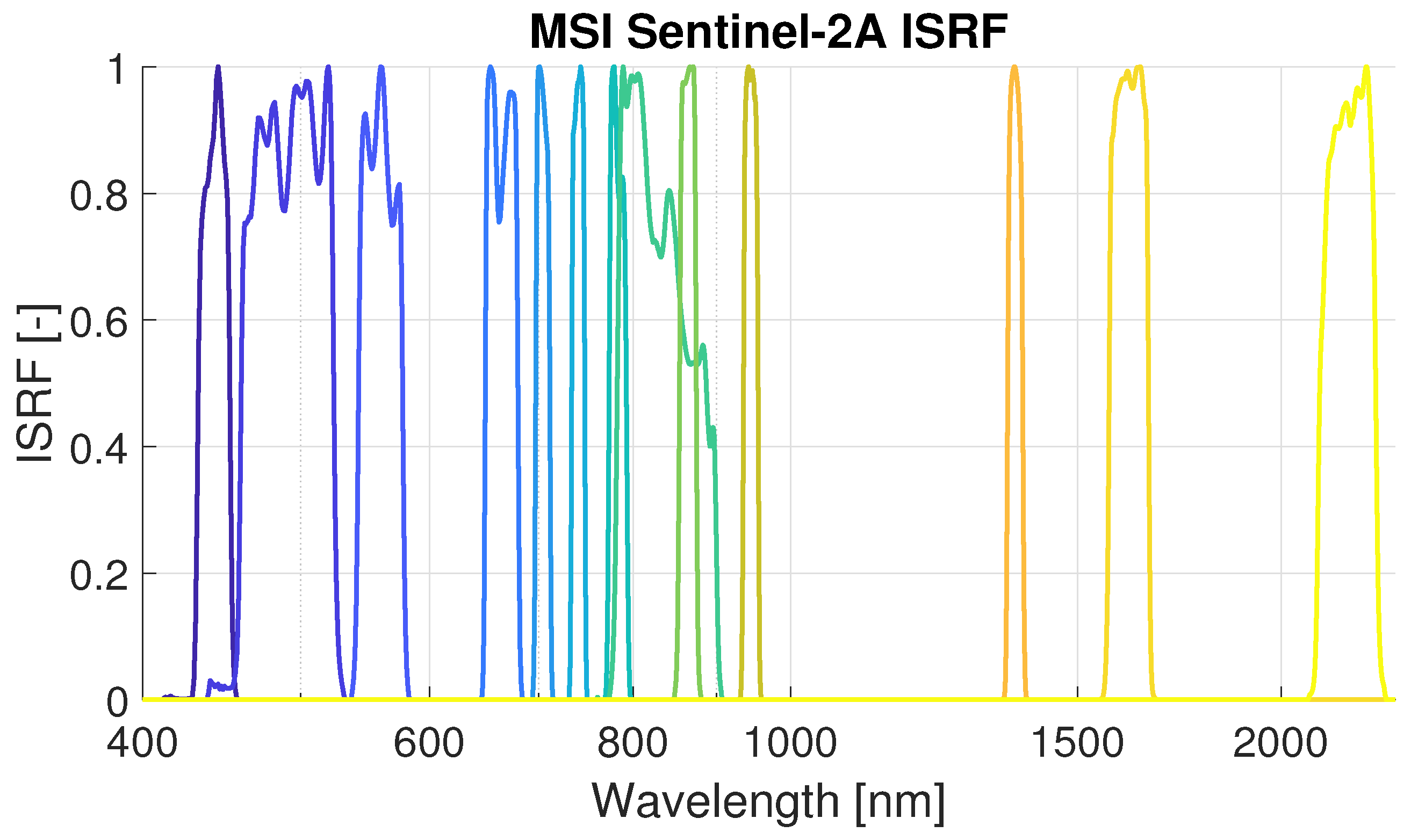
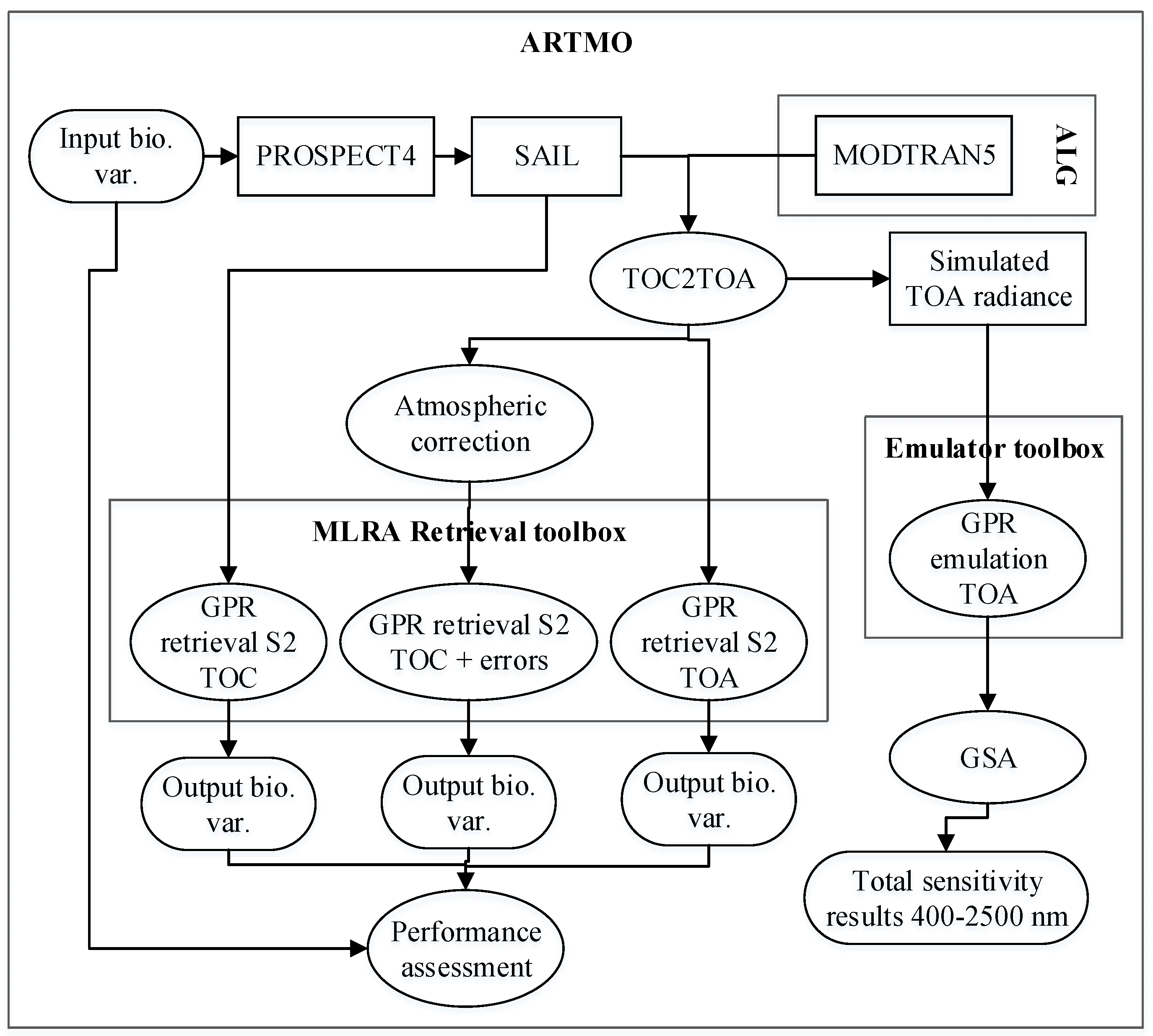

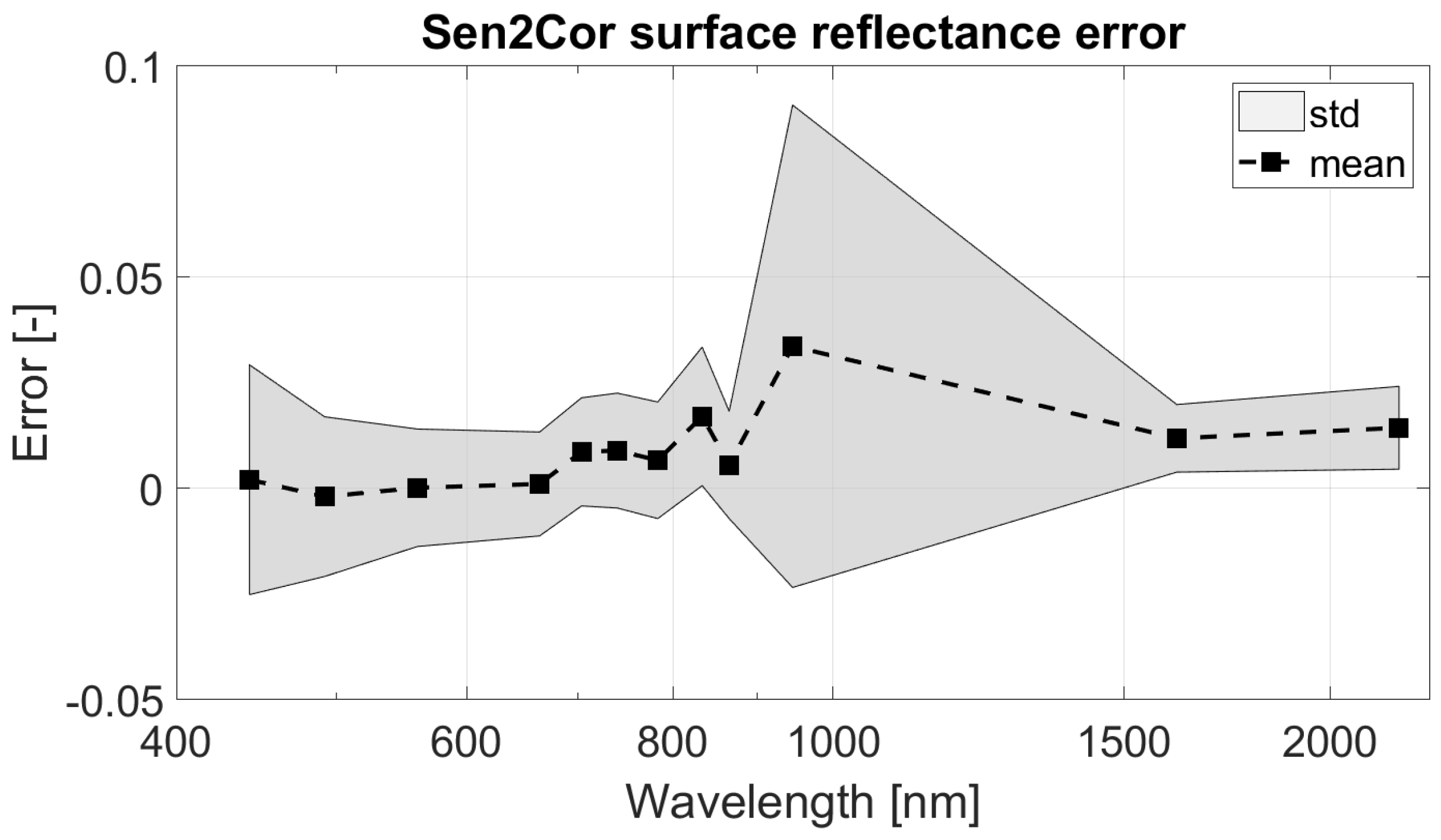
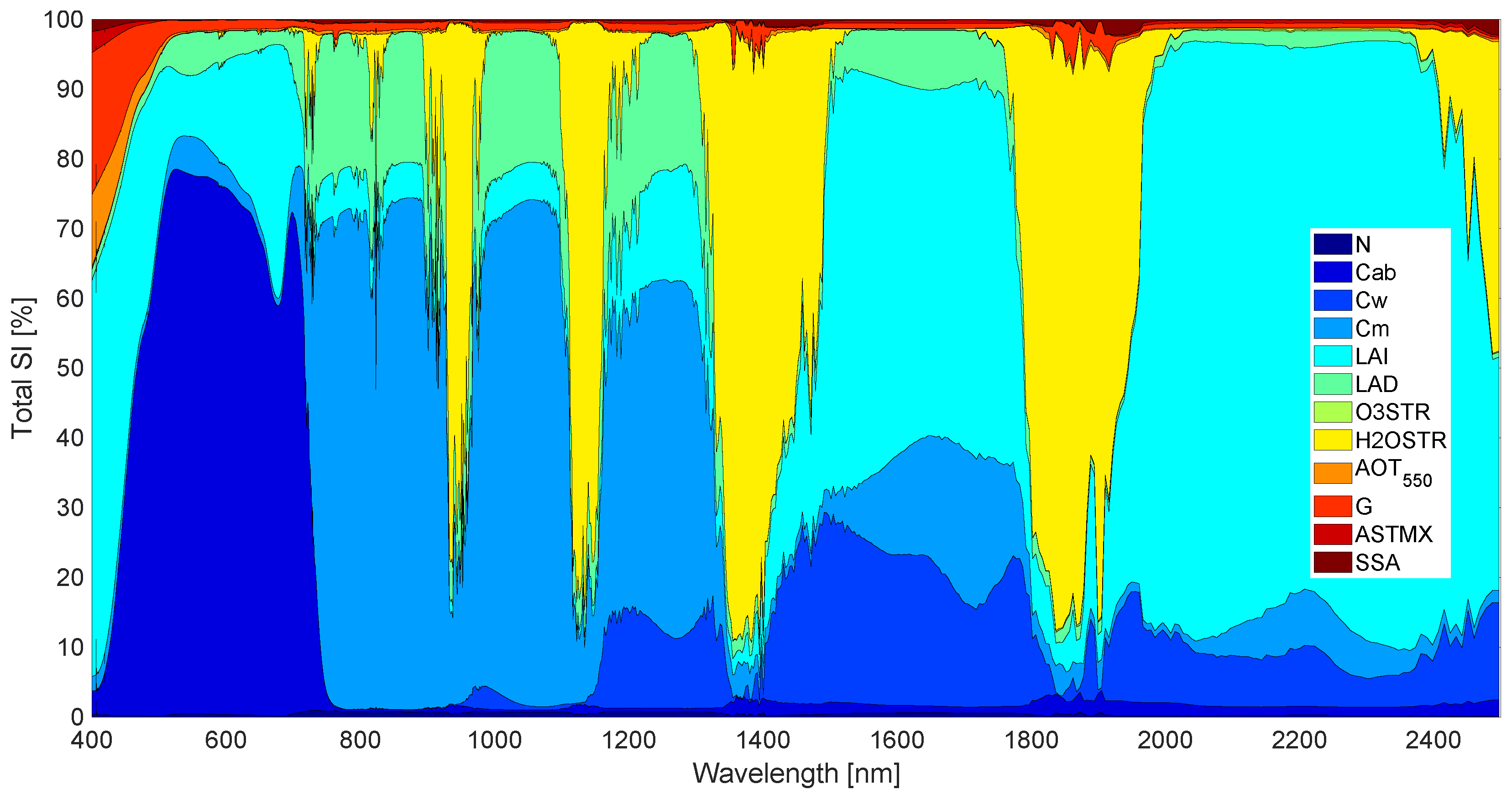

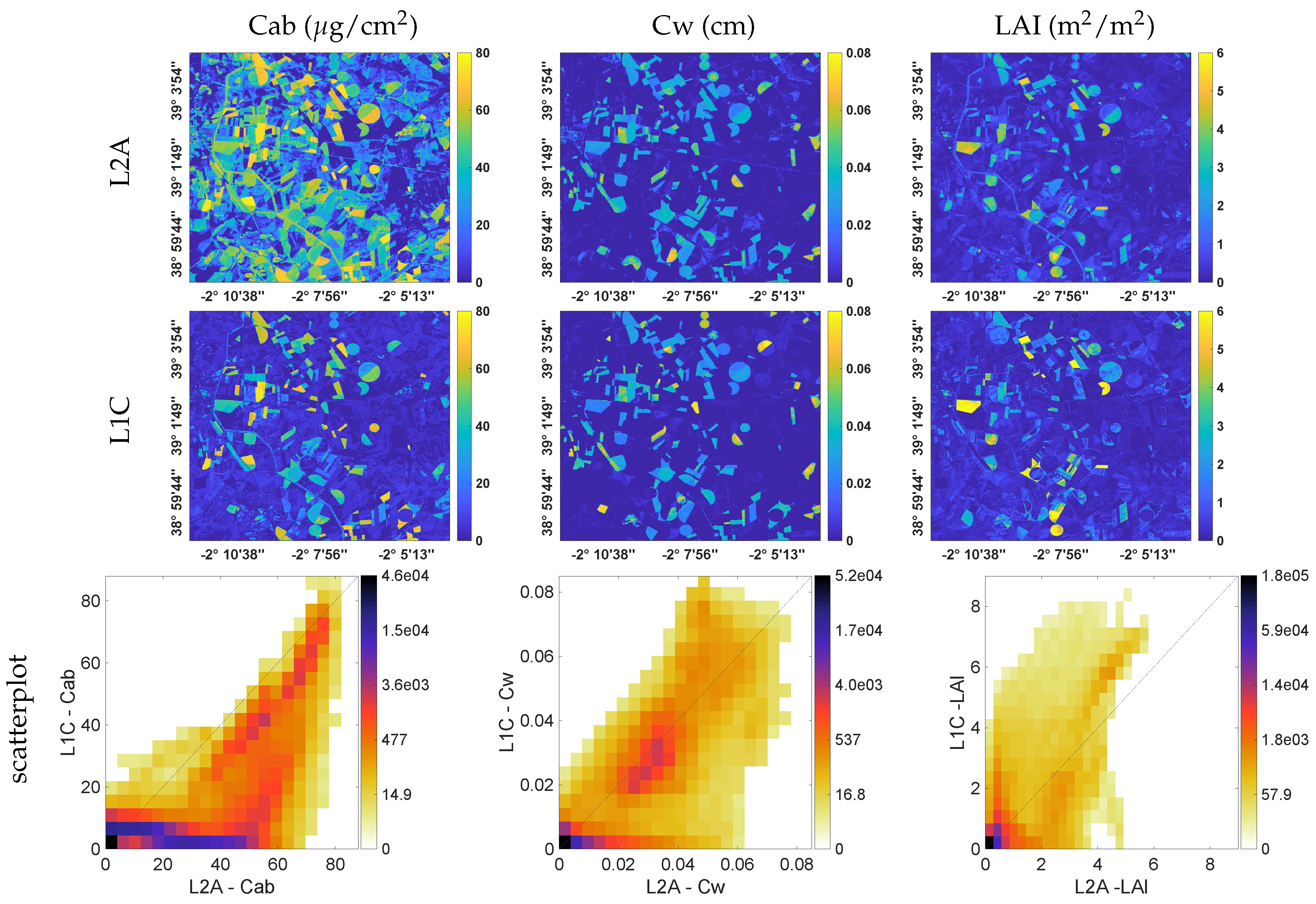
| Technical Characteristics | Value |
|---|---|
| Imaging principle | Pushbroom-grating |
| Spectral range [nm] | 400–2200 nm |
| Geolocation accuracy | <12.5 m |
| SNR @L | 50–175 |
| Radiometric accuracy | 3% abs, 1% rel |
| A/D conversion | 12 bits |
| Coverage | Land and coastal areas |
| Model Variables | Units | Minimum | Maximum | |
|---|---|---|---|---|
| Leaf variables (PROSPECT-4) | ||||
| N | Leaf structure index | unitless | 1.3 | 2.5 |
| Cw | Leaf water content | [g/cm] or [cm] | 0.002 | 0.05 |
| Cab | Leaf chlorophyll content | [g/cm] | 1 | 70 |
| Cm | Leaf dry matter content | [g/cm] | 0.002 | 0.05 |
| Canopy variables (SAIL) | ||||
| LAI | Leaf area index | [m/m] | 0.1 | 7 |
| LAD | Leaf angle distribution | [] | 0 | 90 |
| Model Variables | Units | Minimum | Maximum | |
|---|---|---|---|---|
| O3C | O column concentration | [amt-cm] | 0.25 | 0.35 |
| CWV | Columnar Water Vapour | g·cm | 0.4 | 4.5 |
| AOT | Aerosol Optical Thickness at 550 nm | unitless | 0.05 | 0.5 |
| G | Asymmetry parameter | unitless | 0.6 | 1 |
| Ångström exponent | unitless | 0.05 | 2 | |
| SSA | Single Scattering Albedo | unitless | 0.85 | 1 |
| Model Variables | Units | Minimum | Maximum | |
|---|---|---|---|---|
| O3C | O column concentration | [amt-cm] | 0.25 | 0.35 |
| CWV | Columnar Water Vapour | g·cm | 0.4 | 4.5 |
| AOT | Aerosol Optical Thickness at 550 nm | unitless | 0.05 | 0.5 |
| Aerosol type | 9 types (see text above) | |||
| Retrieval: | TOC | TOA | TOC-ATM |
|---|---|---|---|
| R: | |||
| - Cab | 0.972 | 0.948 | 0.907 |
| - Cw | 0.942 | 0.908 | 0.813 |
| - LAI | 0.684 | 0.623 | 0.520 |
| RMSE: | |||
| - Cab | 3.312 | 4.586 | 6.077 |
| - Cw | 0.003 | 0.004 | 0.006 |
| - LAI | 1.120 | 1.223 | 1.381 |
© 2019 by the authors. Licensee MDPI, Basel, Switzerland. This article is an open access article distributed under the terms and conditions of the Creative Commons Attribution (CC BY) license (http://creativecommons.org/licenses/by/4.0/).
Share and Cite
Verrelst, J.; Vicent, J.; Rivera-Caicedo, J.P.; Lumbierres, M.; Morcillo-Pallarés, P.; Moreno, J. Global Sensitivity Analysis of Leaf-Canopy-Atmosphere RTMs: Implications for Biophysical Variables Retrieval from Top-of-Atmosphere Radiance Data. Remote Sens. 2019, 11, 1923. https://doi.org/10.3390/rs11161923
Verrelst J, Vicent J, Rivera-Caicedo JP, Lumbierres M, Morcillo-Pallarés P, Moreno J. Global Sensitivity Analysis of Leaf-Canopy-Atmosphere RTMs: Implications for Biophysical Variables Retrieval from Top-of-Atmosphere Radiance Data. Remote Sensing. 2019; 11(16):1923. https://doi.org/10.3390/rs11161923
Chicago/Turabian StyleVerrelst, Jochem, Jorge Vicent, Juan Pablo Rivera-Caicedo, Maria Lumbierres, Pablo Morcillo-Pallarés, and José Moreno. 2019. "Global Sensitivity Analysis of Leaf-Canopy-Atmosphere RTMs: Implications for Biophysical Variables Retrieval from Top-of-Atmosphere Radiance Data" Remote Sensing 11, no. 16: 1923. https://doi.org/10.3390/rs11161923
APA StyleVerrelst, J., Vicent, J., Rivera-Caicedo, J. P., Lumbierres, M., Morcillo-Pallarés, P., & Moreno, J. (2019). Global Sensitivity Analysis of Leaf-Canopy-Atmosphere RTMs: Implications for Biophysical Variables Retrieval from Top-of-Atmosphere Radiance Data. Remote Sensing, 11(16), 1923. https://doi.org/10.3390/rs11161923








